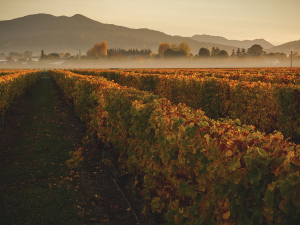"There is no doubt we urgently needed an improved harvest this year after cool weather and frosts impacted Vintage 2021," New Zealand Winegrowers (NZW) Chief Executive Philip Gregan told attendees of Grape Days events in Hawke's Bay, Marlborough and Central Otago in June.
According to the 2022 Vintage Survey, New Zealand's total grape tonnage in the 2022 harvest was 532,000 tones, well up on the 370,000 tonnes harvested in 2021, which was a drop of 19% on the year before. The NZW estimates show that virtually every region played a role in that leap of fortunes, with only tiny player Northland recording a drop, and Hawke's Bay, with 40,172 tonnes, just 2% down on 2021.
Marlborough harvested 414,649 tonnes, 54% up on the 269,521 tonnes of 2021, making up 80% of the national harvest. Meanwhile, Central Otago, which bucked the trend in 2021, with a 21% increase on 2020, raised its harvest numbers by another 22% this year, harvesting 12,575 tonnes in the 2022 vintage.
Sauvignon Blanc made up 76.5% of the national tonnage, with a whopping 393,956 tonnes, up 47% on 2021. But Pinot Noir had the biggest percentage lift, with 34,569 tonnes, up 57% on the previous year, making up 6.7% of the national harvest. Pinot Gris and Chardonnay, at 5.9% and 5.8% of the total harvest respectively, were both well up on last year, with Pinot Gris leaping 45%.
Philip says grape growers and wineries are feeling relieved at the prospect of rebuilding stocks and sales, having watched supply lines steadily dwindle. "Going into vintage, wineries urgently needed a larger harvest as strong demand and smaller than expected crops in recent years had led to a significant shortage of New Zealand wine."
That shortage caused total New Zealand wine sales to fall 14% - at least 50 million litres - from the peak achieved in January 2021, "even as wineries supported sales wineries supported sales by drawing on stocks which are now at rock-bottom levels," he says. Wine companies called down at least 40 million litres from stocks, says Phillip, noting the 90 million litre shortfall. In the domestic market, the same shortage has led to sales of New Zealand wine falling to their lowest level since 2004.
The harvest was beset by challenges around labour force and Covid-19, with the Omicron variant spreading rapidly through the country just as vintage kicked off, hitting companies already working with sparse numbers and a lack of experience.
Wither Hills head winemaker Matt Large says an unexpected bonus of the low 2021 vintage was having an empty winery as they charged into the higher yielding 2022 harvest. "It was full to the brim and then some," he says, comparing the final leg of Vintage 2022 to a game of Tetris, trying to make each space work better.
The bumper harvest has allowed them to resume promotions in New Zealand, which they paused as wine stocks dwindled, to eke out the remaining supply. Offshore they pulled similar levers, slowing momentum on growth opportunities to reduce empty shelves.
Now, with the first 2022 Sauvignon bottled in early July, "a little earlier than usual", they are looking forward to resuming supply domestically and internationally, "in full sales mode". Matt says the strength of brand-New Zealand, and brand-Marlborough Sauvignon Blanc, is "really strong", so they've weathered the shortfall from 2021. "People might have bought another wine as a gap filler, but all the talk we are hearing is that they will quickly go back to it as soon as it's back in stock."
The 2021 vintage was Saint Clair Family Estate's smallest since 2015, while 2022 was their biggest vintage yet, up by 50% on last year. Owner Neal Ibbotson says that variation in yield between harvests - created to a large extent by temperature at flowering - is one of the larger challenges for the wine industry. "It is difficult to balance this large variation in yield whilst at the same time keep our loyal customers with their continued supply," he says. "A good harvest for 2022 was indeed needed and we were lucky enough to receive it. However, because of the very small 2021 vintage and the continued demand for Marlborough Sauvignon Blanc, it continues to be a challenge to supply our international market demand."
Meanwhile, the company is also facing challenges around increasing costs, staff shortages, shipping availability, and ongoing increasing bureaucracy.
Philip says that while the improved harvest is good news for the industry and customers, allowing producers to "rebuild seriously depleted stocks and sales", there are plenty of challenges ahead, including the logistics involved in getting wine to market, given continuing supply chain disruptions. "Every winery I talk to, the number one thing they talk about is logistics. Now with a larger vintage, it's particularly importants to get that offshore."
He also flags the rising cost of doing business, with inflation at its highest level in more than 30 years, and significant cost increases "across the board", including excise jumping 6.9%, or 22 cents per litre from 1 July, and continued increases in the minimum wage. Meanwhile, labour supply continues to be a constraint.
However, the industy is well positioned for the future. "Our global reputation is stronger than ever in most markets. Our sustainability credentials are strong, with government and our customers. With vintage 22 in tank, after all the shortages of the past year, we have got the product to rebuild stocks, and rebuild our sales and export markets - particularly in North America where there's good opportunity - and restore exports into markets which have been seriously undersupplied from Vintage 2021," says Philip.
"So despite these challenges after vintage 22 I think we have got a very positive platform to build for the future."












